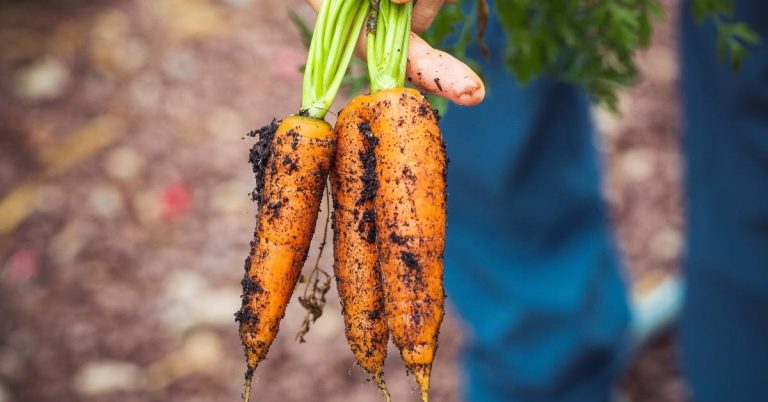Are you enjoying the summer harvest and picking homegrown vegetables and herbs? Maybe you were sidetracked, and your plans to start a vegetable garden just didn’t take off. Now that fall is on its way, you’re forced to wait until next spring and summer to plant, right? You might be happy to know that’s not the case. Just because fall is on the horizon, you don’t have to put away your gardening tools. When you know how to plant a fall garden, you’ll be able to enjoy homegrown produce during the fall season.
Although the chilly fall weather can make growing crops a little tricky, there’s still a wide variety of fall garden vegetables you can grow. Crops that grow in the fall take a bit more time to mature due to the lack of sunlight as the season starts to wind down. However, in many temperate zones, fall garden plants are usually ready to be harvested in September or October. In areas that have mild climates, such as the Pacific Northwest, crops are able to be planted and grow, but they require a lot of attention.
We’ve compiled a fall garden checklist to make the process a whole lot easier. Keep reading to learn the ins and outs of planning a fall garden.
Start Off Early
In most cases, by the time most people start thinking about planting fall garden veggies, they’re too late. To have a successful winter harvest, you’ll need to start planting as soon as summer hits its peak. In a majority of areas, this means you’ll have to plant during August’s heat. Planting at that time will give your crops the time they need to grow while the weather is still good. The exceptions are crops like radishes and lettuce, which grow fast; you can plant those as late as September. However, crops like carrots and broccoli require several months of adequate growing conditions to mature before the frost hits.
Don’t Hesitate
Most crops that are planted in the summer typically take two extra weeks to mature. That extended maturation period is because the air is cooler and the days are shorter. A lot of people tend to hesitate when they hear that because they don’t want to wait a long time for their plants to grow. However, a little planning can go a long way. Here’s a way you can properly plan your fall garden:
• Look at the plant tag or seed packet to find the “days to maturity” figure.
• Count those days backward from the frost date.
• Count back two more weeks to account for the fall factor.
Following the steps above will help you determine the “plant by” date for your fall crops. Doing this will make setting your fall gardening date much easier.
Learn How Long It Takes for Your Crops to Grow
Every crop has somewhat of a predictable life expectancy. This means that you’re able to predict how long it’s going to take for your fall garden flowers to bloom. The life expectancy of the crop is typically defined by “days to maturity,” a figure that is listed on the plant tag or seed package. Of course, the days to maturity depends on the environment the plant requires, but the numbers listed on the package are usually accurate. As a rule of thumb, you should always plan your fall planting so that your crops have the time they need to mature.
Harvest Your Spring and Summer Crops Immediately
Before you plan for fall planting, consider harvesting all of your spring and summer crops. A successful fall planting depends on how you’ve maintained your spring and summer crops. Most gardens often have limited space, so it’s crucial that your early-season plants are harvested and taken away from the garden.
Here is a short list of crops that might finish growing during midsummer:
• Onions
• Garlic
• Carrots
• Potatoes
• Cauliflower
• Broccoli
• Cabbage
• Beets
As you choose your fall crops to add to the garden, make sure to take inventory of the current crops that you can harvest. Doing so will allow you to figure out how much space will be available, and you can prioritize which crops to plant for fall.
Crops Last Longer During the Fall Season
You might think that the cold weather that comes with fall and winter is bad for your plant’s health. On the contrary, planting in the fall turns your garden into an outdoor refrigerator. As the fall season goes on, mature crops are able to hold on longer due to the cool weather. Some crops, such as kale, broccoli, and cabbage, are able to live for months at a stretch after they’ve matured, so consider those plants if you’re looking for fall garden bed ideas. The same rings true for fast-growing crops like cilantro and lettuce. With the proper planning, you might be able to harvest from your garden through the chilly season and into the spring.
Add Some Fall Garden Décor
Who said a garden had to be all about the crops? Anyone can dig a hole, throw in some seeds, add water, and call it a day. But, why do that when you can show your garden how much you care for it? You may be wondering, “What is considered to be fall garden decor?” Anything that represents the fall season is decor, ranging from pumpkin signs to garlands to fall garden bulbs. If you need some inspiration, check out these fall garden design ideas.
You now know how to prepare a fall garden with very little trouble. Let your green thumb be your guide.
If you need space to store your out-of-season garden decor, check out the climate controlled units at StorageMart. Homeowners can rent units for the period of time that works for them since no long-term contracts are required. Contact our storage experts to reserve your unit today.


